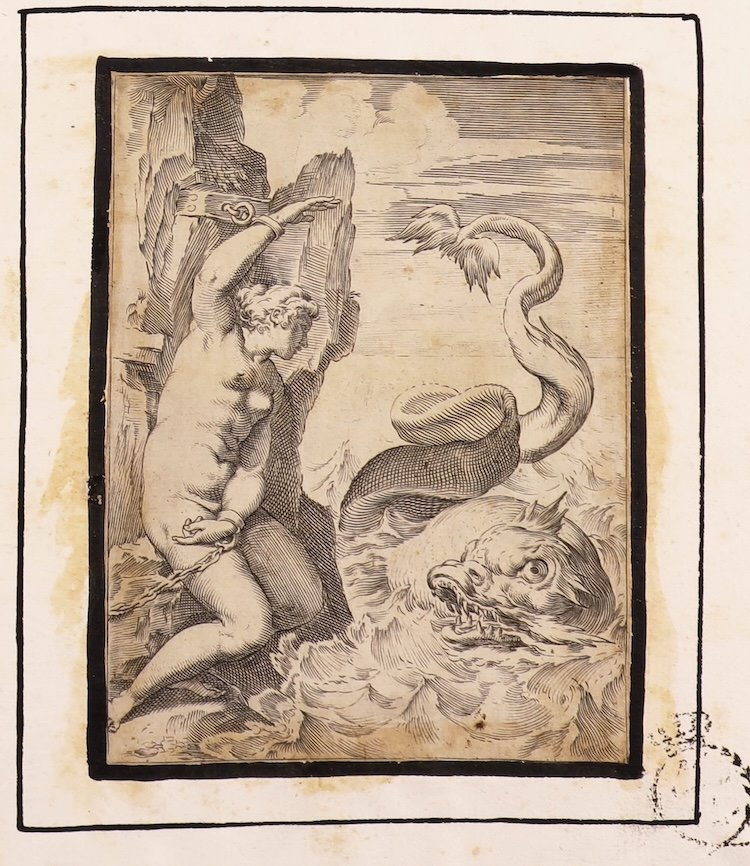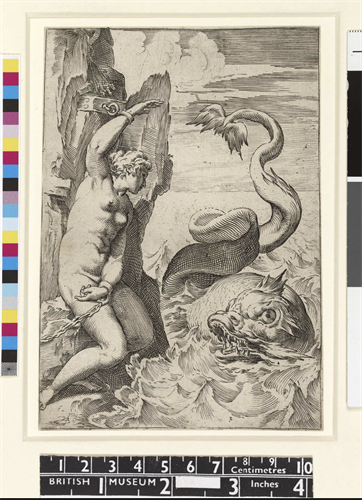Andromeda e il mostro marino
Scuola Romana, inizi XVII secolo
Agostino Carracci (1557-1602)
Circle of
Andromeda and the Sea Monster
from an engraving by Agostino Carracci (1557-1602)
Oil on canvas
75 x 59 cm.
In frame 96 x 77 cm.
The subject of the painting, derived from Ovid's Metamorphoses, is inspired by the myth of Princess Andromeda, daughter of King Cepheus of Ethiopia and Queen Cassiopeia, who, tied to a rock, is about to be attacked by a sea monster sent by Poseidon at the request of the Nereids.
The heroine's misfortune was to have a mother who praised her own beauty as superior even to that of the Nereids, the sea nymphs who were daughters of the god of the sea. According to mythology, the young woman was therefore chained to a rock and offered as a sacrifice to the terrible monster sent to appease the wrath of the nymphs, who were offended by Cassiopeia's unforgivable pride.
This myth was very popular in Roman Baroque painting, often commissioned as a subject to decorate the sumptuous private rooms of the aristocratic palaces of Rome. Despite her Ethiopian origins, Andromeda is immortalised with white skin, a detail that was intended to appeal to the tastes of the patrons of the time, who would certainly not have appreciated a black-skinned figure as a beauty to be admired.
Considering the context, the canvas seems to have been created to offer the observer an image of a female nude in an extremely sensual, almost erotic pose, as an object of pleasure for aristocratic patrons of the 16th and 17th centuries, who delighted in owning such compositions and displaying them in their collections.
The work, which can be attributed to an artist active in Rome in the 17th century, draws direct inspiration from an engraving by Agostino Carracci, dating from around 1590 (fig. 1, https://www.britishmuseum.org/collection/object/P_U-2-154).
The beautiful maiden is depicted according to an iconography particularly dear to artists of the period, with a pose reminiscent of classical goddesses, completely naked and chained to a rock and, just as described in Ovid's words, highly sensual.
“As soon as he (Perseus, her liberator) saw her bound by her arms to the hard rock, had it not been for a slight breeze moving her hair and the warm tears flowing from her eyes, he would have thought her a marble statue... without knowing it, he was set ablaze and remained astonished and enraptured by the image of beauty he saw...” (Metamorphoses IV, vv. 672-683).

ADDITIONAL INFORMATION:
The work is sold complete with a gilded wooden frame and comes with a certificate of authenticity and a descriptive iconographic card.
We take care of and organise the transport of purchased works, both in Italy and abroad, through professional and insured carriers.
It is also possible to view the painting in our gallery in Riva del Garda. We would be delighted to welcome you and show you our collection of works.
Please contact us, without obligation, for any additional information.
Follow us on:



